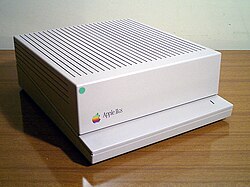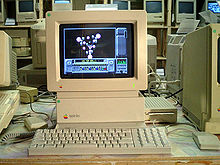Apple IIgs
| Apple IIgs | |
|---|---|

|
|
| Manufacturer | Apple |
| Presented | September 1986 |
| Discontinued | December 1992 |
| Recommended sales price | US $ 999 (approx. 3,500 to 5,000 DM, each with / without color monitor and the 3.5 "drives) |
| CPU | 65C816 , 1 or 2.8 MHz |
| R.A.M. | 256 KiB (later 1.125 MiB), max. 8/9 MiB |
| OS |
ProDOS 16, GS / OS |
The Apple II GS personal computer was introduced in September 1986 as the successor to the Apple IIe . It was the fifth and last model in the Apple II series , if you don't count the Apple IIc Plus , a faster version of the Apple IIc only available in the USA . The Apple II GS was the last computer that Apple co-founder and father of the Apple II series, Steve Wozniak , had designed for Apple before he ended his active engineering work at Apple in February 1985; after that he remained an employee, but only performed PR tasks for Apple.
The "GS" stands for Engl. " Graphics " and " Sound ". The Apple II GS was a hybrid machine that on the one hand could use software and hardware from the Apple II series and on the other hand (but not in time for the market launch) had a similar graphical user interface as that of the Macintosh . In contrast to the black and white representation of the Macintosh at that time, a color GUI was offered here for the first time on an Apple computer; However, the Macs of that time had a higher vertical image resolution and were significantly faster.
history
Compared to all previous computers in the Apple II series, the II GS had a real 16-bit architecture, a higher clock frequency, direct access to several megabytes of memory, a new design, and support for 3.5-inch floppy disk drives with more storage capacity and a mouse as standard equipment (extra costs for Apple IIe / IIc approx. 300 DM). The keyboard and mouse were connected via the new Apple Desktop Bus (ADB), which is considered one of the technical ancestors of the Universal Serial Bus .
At that time, Apple had to bring a product that was competitive in price and performance against the Atari ST and the Commodore Amiga (the IBM PC did not have a noticeably widespread graphical user interface at the time) without endangering the high-priced Apple Macintosh .
For users who did not want to use old 8-bit software, but only new 16-bit software, the price / performance ratio of the Apple II GS was significantly worse compared to its direct competitors Atari ST and Commodore Amiga - the Apple offered less speed and fewer graphics acceleration options for games at a higher price, so that significantly fewer games then appeared for the system. The Apple was only superior to its competitors in the sideline areas: quality of workmanship, quality of documentation and compatibility with existing software. It was only later that the GS / OS operating system, which was completed with a delay, was able to make up ground in another area, as it was much more stable than the competing products that were available at the same time.
At that time there was so much internal controversy at Apple that both founders ended their active involvement, Steve Jobs even left the company completely. The "vernacular" was of the opinion that Apple has thrown itself out of the market because the right people at Apple have not managed the company. The Apple II GS was hardly further developed - a version called "ROM 3" appeared in 1989, which had been corrected for various errors, with more built-in memory and a slightly improved operating system, but which offered no speed increase and no real new features - the company was completely out of place focused on the Macintosh. The Apple II line was manufactured until 1992.
Technical specifications
Main processor
The main processor was a 16-bit 65816 / 65C816 processor from Western Design Center (WDC), which was able to establish software compatibility with the 8-bit 6502 / 65C02 from MOS Technology in the Apple II / IIe / IIc. A software switch in the processor decided whether the processor was running in 8-bit emulation mode or in 16-bit mode (native mode). In 8-bit mode, it could be addressed with the same commands as an Apple II / IIe / IIc and thus also ran with its software (with the choice between the two speeds 1 or 2.8 MHz), but with the same memory limit of 64 KiB address space (emulated 16-bit address bus), which could only be circumvented indirectly by bank switching . The processor is still in production today.
The number "65" in the product name of the WDC 65816 / 65C816 indicates the compatibility with the 6502 / 65C02 from MOS Technology. The number "816" means that the processor can work in 8- and 16-bit mode. The processor can address a maximum of 16 MiB RAM in 16-bit mode (with 24-bit address bus). However, hardware restrictions prevent the II GS from expanding the memory beyond 8.25 MiB (9.125 MiB in the later model).
Memory - RAM
The 1986 II GS had 256 KiB of RAM, the 1989 model had 1.125 MiB. The RAM was divided into 128 KiB (4 chips each) "fast" and "slow" RAMs. The "faster" memory was only used for programs. The "slower" memory, equivalent to the memory of the Apple IIe, was used for screen output, I / O processing and as system memory. The 1989 model still had 128 KiB of slow memory, but 1 MiB of fast memory. For 16-bit programs a maximum of 176 KiB RAM was available with 256 KiB RAM (128 KiB faster RAM + system memory, depending on the resolution and equipment (expansion cards)). The RAM memory could be expanded to a maximum of 8.25 MiB (1989 model: 9.125 MiB) using expansion cards, whereby expansions beyond the 4.25 or 5.125 MiB officially supported by Apple require changes in the operating system. The extensions only increase the "fast" memory, the "slow" memory always remains at 128 KiB.
Almost all II GS -specific programs, including all but the earliest versions of the GS / OS operating system, require a total memory expansion of at least 1 MiB. On the 1986 model, almost only the conventional 8-bit programs of the Apple IIe / IIc can be used without a memory expansion card. From 4 MiB, practically all existing programs run without any problems, a memory expansion beyond this then only serves to reduce the frequency and duration of drive accesses.
Storage ROM
The II GS had 128 KiB ROM (1986 model) or 256 KiB ROM (1989 model). The ROM could be expanded to a maximum of 1.125 MiB or 1.25 MiB using expansion cards, but hardly any use was made of this.
Sound
In contrast to its predecessors, which only offered an even simpler version of the PC system loudspeaker without additional sound cards, the Apple II GS had an Ensoniq ES-5503-DOC (digital oscillator chip) sound chip from the developer of the MOS Technology SID on the motherboard how he z. B. also used Ensoniq itself for its synthesizers Mirage, ESQ-1 and SQ-80. This chip had its own 64 KiB memory to store and edit digital music. The chip had a digital-to-analog converter and 32 oscillators , two of which Apple used in the firmware of the II GS for internal purposes. The rest were used for sound generation, either as 15 stereo voices or as 30 mono voices. The chip was also able to generate tones using what is known as wavetable synthesis. Two digital-to-analog converters (DACs - Digital Analog Converters) were available for this, which had a resolution of 8 bits and could access an internal 64 KiB wavetable memory. Thus, the Ensoniq 5503 was able to generate digital stereo sound similar to the Commodore Amiga , the largest competitor product at the time . However, Apple limited the sound output by only installing a mono connection for headphones / speakers. With the help of an additional (passive) expansion card, a stereo output signal could be obtained.
Apple Corps , the Beatles' rights company , filed a lawsuit against Apple Computer because of these sound options, as they believed they had violated the agreement between the two companies that Apple Computer was only allowed to use the name "Apple" as long as it was not used in music -Business have been active. As a consequence, Apple Computer no longer built dedicated sound chips into its Macintosh models for many years.
graphic
The integrated graphics chip had a 12-bit color palette (4096 colors) and could display the following additional modes in addition to the graphics modes of the Apple IIe :
- 320 × 200 with 16 colors
- 320 × 200 with 16 color palettes of 16 colors each: Here each line of the image could be provided with a different color palette. This enabled a representation of theoretically 256 colors.
- 320 × 200 with 200 color palettes of 16 colors each: Each line of the image could be provided with a color palette, which theoretically enabled 3200 colors to be displayed.
- 320 × 200 with 200 color palettes of 15 colors each + a fill color:
- 640 × 200 in four colors: This mode was only used for menu operations and for the Apple logo.
- 640 × 200 in 16 simulated colors: Here, a representation of 16 colors was simulated with the help of two color palettes of four colors each, each used in a different area of the image. This mode was the mode for office programs. Such modes were quite common at the time.
Power supply of the real-time clock
A ½AA battery with 3.6 V, firmly soldered in early models, replaceable in later motherboard versions.
literature
- David D. Thornburg: The New Apple II GS . In: COMPUTE! No. 78 , 1986, pp. 18 ( atarimagazines.com [accessed November 5, 2019]).
